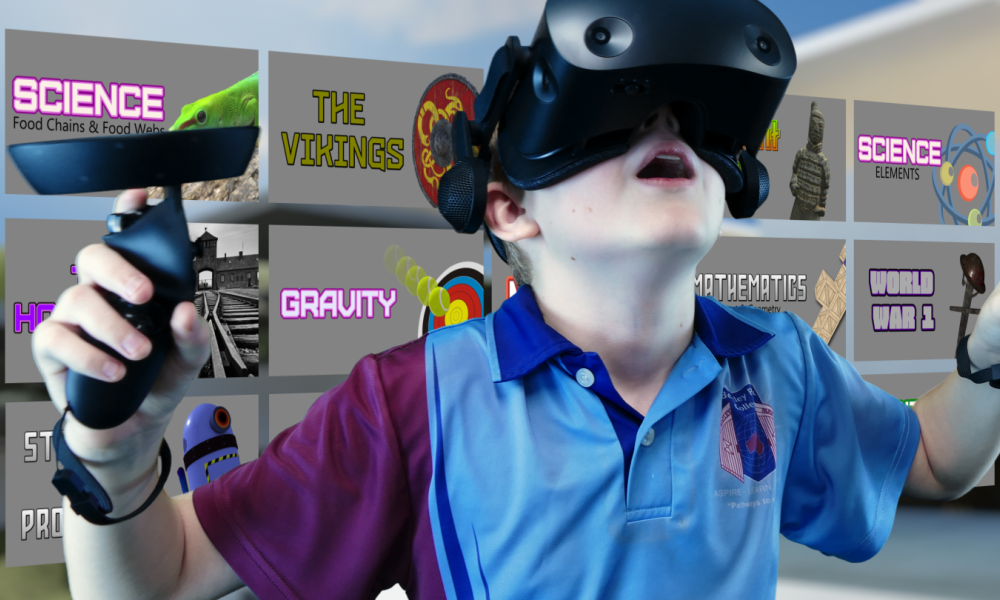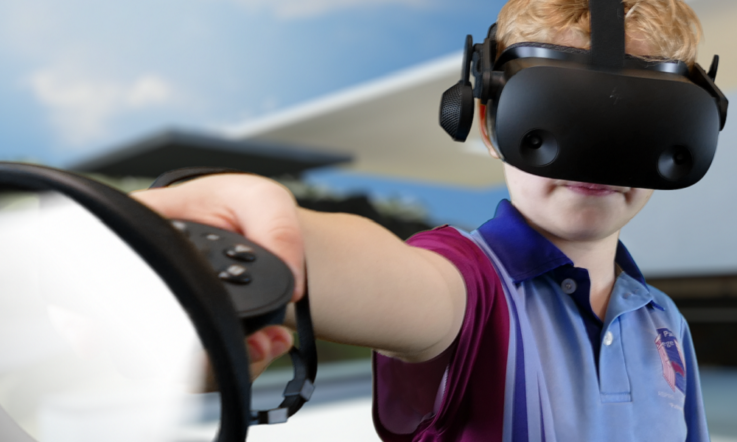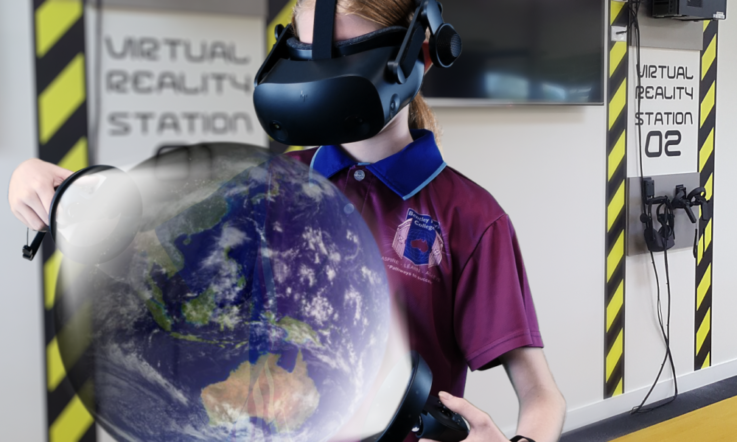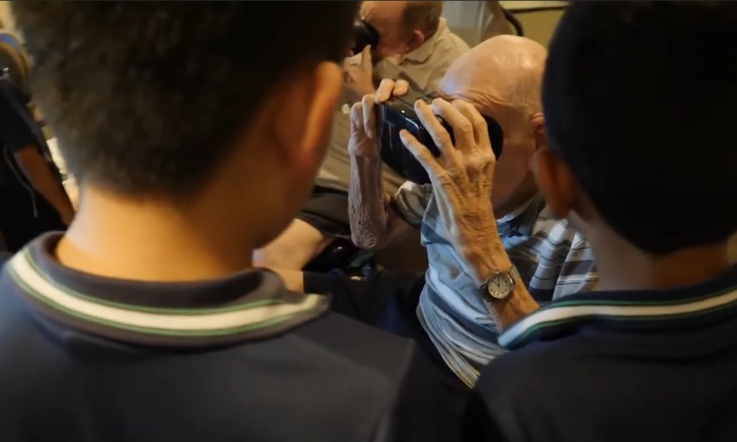In their series for Teacher on Virtual Reality in education, Curriculum Designer Dr Susan O’Donnell and Project Manager Adrian Rayner at VR Learning & Design Hub, Cairns Southern Corridor, have explored the potential of virtual reality technology and five elements of a successful school program. In this final instalment, they share feedback from students and staff who have been using the technology in their learning and teaching.
‘That’s the best way to learn Science! If I could learn like that, I would come to school for Science … (quiet sigh); even although I have to anyway!’ After experiencing a series of learning activities in Virtual Reality (VR), this was the verdict from a Year 7 student not known for his enthusiasm for learning.
His excited support for VR, however, expresses more than pleasure. There’s a sense of frustration too with his usual classroom experience and VR seems to represent a new way of thinking about learning. But what of the others who have engaged with VR as a tool in learning and teaching? What have they experienced and how do they rate its impact?
These questions have compelled the VR Team to seek and analyse feedback from students and teachers alike. Surveys invite participants to rate features in our VR model and share comments. Over two years, the results have provided a wealth of quantitative and qualitative data, shaping our theoretical thinking and continuous improvement of modules.
Student voices
Let us first introduce our students. The student body of the state secondary schools in our Cairns Southern Corridor share similar features. They come from multicultural, diverse and often struggling socioeconomic communities with large Aboriginal and Torres Strait Islander populations. Many students are high energy, with strong peer connections but are often disengaged, struggling with literacy and formal learning skills. They tend to act and do, before they think. However, when engaged and free to learn through experience rather than textbook, they respond with enthusiasm.
Their feedback about their experience of VR has been consistently very positive. They deeply value the immersive VR experience, finding it helpful for improving understanding of abstract concepts. They highly rate the freedom to self-direct their learning. They embrace the inquiry approach as a challenge to take on together. In VR, literacy is not a barrier! ‘Trial and error’ is not failure but another chance to get it right! Valuing their teacher’s support, they newly see themselves as successful learners, achieving at their own pace, in their own way.
The use of the word ‘fun’ is the most used word in student comments, suggesting a high level of engagement. The VR experience is one of ‘being really there’, an exciting, realistic, interactive and relevant context for learning. They attest to gaining new perspectives and a new appreciation of how accessible learning can be. ‘Everything we did was 100 per cent relevant to our education’ says one; ‘One of the most creative days at school ever’ says another; ‘This is a good way to learn. Being able to see and hear while also visualising it is a very good way to absorb information while keeping you interested’ sums it up.
These comments represent just a brief snapshot, but one theme is clear – learning with VR has much to offer. In fact, the most frequent complaint from students was that they needed and wanted more time! It confirms what Manuel Fernandez (2017) argues, ‘The main facilitators for the adoption of this technology within the education sector are the students themselves’.
Teacher voices
Teachers support what students have said, reporting higher levels of student engagement, not just when they are in the VR headset, but also in the other learning activities. They (and we, the VR Team) have witnessed surprising levels of knowledge retention and a general absence of negative behaviours. Students take time to think and work well in collaborative partnerships. They step out of their comfort zone, more comfortable with asking questions and taking on the learning challenge. This has contributed to deeper learning. Here’s a snapshot of teacher comments:
‘The kids absolutely loved the VR. Even two days later, they were still jumping with excitement, with lots of information. Nearly two weeks later, they are still drawing from their VR experience when in classroom lesson. It was great to see the kids’ level of interaction’ (Year 7 Humanities teacher).
‘There was so much talk generated; describing positions and providing clues to solve the food chains. The pair really worked as a team and celebrated their achievements as a team.’ (Year 9 Science Special Education teacher).
‘From the start to end [they were] eager to write about their explorations.’ (VR Teacher Aide).
The VR project has borne fruit for teachers themselves. A collaborative community of Faculty Heads and teachers is working across the three schools. VR preparation workload is being reduced by sharing materials and ideas. They are exploring new applications for VR modules across curriculum units and subjects. VR teacher leadership is emerging, boding well for the future as teachers take on the home-grown development of VR in schools.
In summary, feedback confirms that students have:
- enjoyed VR and perceive it as a highly positive, productive learning experience;
- brought positive behaviours to the learning;
- demonstrated high levels of engagement, motivation and learning readiness;
- embraced the collaborative partnerships with peers;
- retained knowledge over significant periods of time;
- utilised a wide range of skills;
- valued self-directed learning and taking responsibility;
- taken risks in their thinking processes; and,
- demonstrated empathy.
The technology has also improved proficiency in inquiry-based learning, better contextualised abstract concepts, and reduced the impact of previous barriers – such as literacy, problem-solving and sustained attention.
There’s still work to be done, such as developing teachers’ readiness to learn, adapt and introduce Immersive Pedagogy into their programs. Some students still find it difficult to self-direct, relying instead on teacher instruction. The work of producing software and resources is also ongoing.
We can almost hear colleagues say ‘Yeah! Right!’ We would disbelieve, too, had we not witnessed students delighting in learning; buzzing with excitement at each new discovery and celebrating success. The only way you will know that this is real is to try it – our prediction is that you will see learning transformed.
We shout a loud ‘hooray’ to those teachers who have stepped out and stepped up, ensuring their students have access to VR learning. We sigh an earnest ‘Come on’ to those who are still unconvinced or unsure; who may still think of VR as another novelty, here today, discarded tomorrow. Whilst students may be the main facilitators as Fernandez (2017) observes, teachers are the drivers of change. If they are not on board, students’ opportunities will be that much poorer.
We will leave the last words to Southgate, Smith and Cheers (2016). They exhort all of us to: ‘Not only “watch this space” but to actively participate in developing ideas and applications for using new and emerging technologies to create deeper disciplinary and interdisciplinary learning and more authentic connection to post-school education and the world of work. This is a call for all those involved in education, to act now. Educators and students, alike, need to “dream-up”, sand-pit, prototype, create proof-of-concept and rigorously apply existing and emerging technologies as tools to ensure fairer educational outcomes and futures.’
References
Fernandez, M. (2017). Augmented Virtual Reality: How to improve education systems. Higher Learning Research Communications, 7(1), 1-15. https://files.eric.ed.gov/fulltext/EJ1150087.pdf (PDF, 326KB)
Southgate, E., Smith, S.P. & Cheers, H. (2016). Immersed in the Future: A Roadmap of Existing and Emerging Technologies for Career Exploration. DICE Report Series (3). National Centre for Student Equity in Higher Education, University of Newcastle, Australia. https://apo.org.au/sites/default/files/resource-files/2016-10/apo-nid69649.pdf (PDF 3.9MB)
When you incorporate a new piece of technology into your teaching, what are the learning outcomes you hope to achieve? How does student and teacher feedback inform your future planning and decision-making?
How could integrating the use of VR into learning activities be used to complement a unit of work you have coming up? What are the barriers to making this happen and how could you work with your colleagues and wider networks to overcome these?



